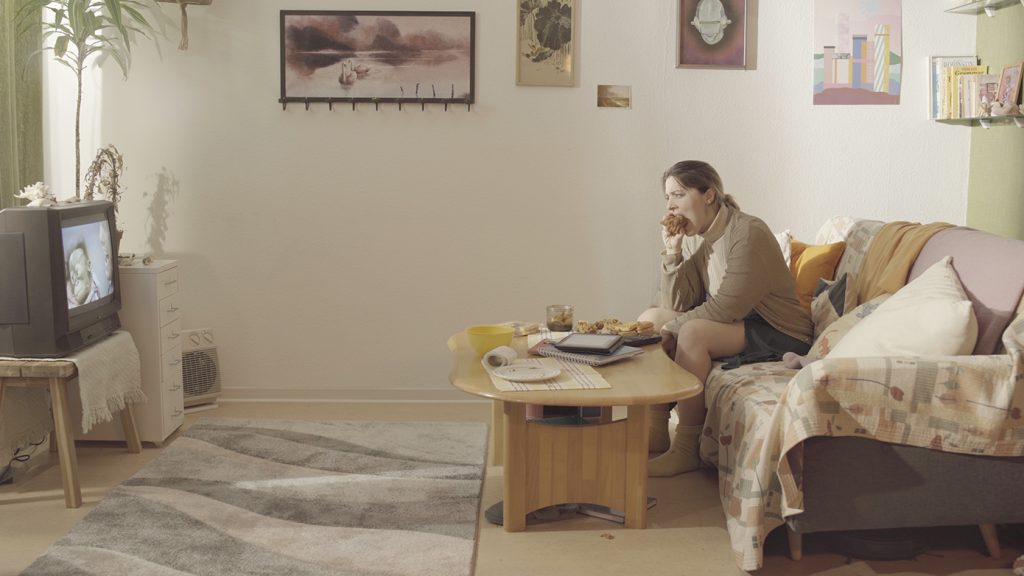INTERVIEW TO DAFNA MAIMON
Elisa Muscatelli
Elisa Muscatelli – How would you describe your artistic research to a new audience approaching to it for the first time?
Dafna Maimon – I like to create experiences that tell stories about how we are put together, how we deal – or don’t really deal – with our emotions, our bodies, and each other. Usually, my works start from an experience, often a frustration, a sense that things could be different.
Exaggeration is a way for me to communicate those feelings. I then look for other stories, images, theories or techniques that both support the original spark, or in fact counter it, broaden it. Then I try to put it together into something that becomes an experience for an audience. Our wrestling with loss, and trauma, our individualist constructs of reality as a whole, and the systems we’ve put in place to operate this reality (patriarchy, consumerism individualism, etc), and our not being in tune with the underlying reality as it is, (for a lack of better words, “the flow of things”), is an ongoing conversation in all of my works.
EM – In your works there are many researching topics and the humor is an interesting point of view for reading them. How important this approach is and how does it influence the realization and the experience of your works?
DM – It’s important to have some lightness, to be playful, otherwise it feels like just more science, “facts”, and perspectives that are bound to be too limited. Work can be play, and when it feels like it, that is usually when I’m doing my best work. Humor is a way to connect with people, but it’s not something I try to do by force, it’s just that usually I don’t have motivation to make anything that doesn’t make me laugh, whether it’s a kind of laugh propelled by sadness, absurdity, or pure joy. Laughing together, and laughing alone, are maybe the most important things. It’s an eruption, like crying or orgasming; humor is just my favorite go-to and the most communal one.
EM – Often, in your performances, as in Wary Mary, Eat All You Can or Opps Hoops, there are universal images, from the womb to the solar system, to the childhood world.
Are these the starting points of your performances, or the landing places of your research?
DM – They are usually starting points, but not always. 🙂
EM – The space, in your works, is essential: from time to time, the viewer is dropped in prehistorical caves or into the kebab and falafel’s restaurant Orient Express, reconstructions which create a short circuit of time.
How important is the relationship with the space and the time inside your artistic practice?
DM – Since, I’m really intent on creating very vivid experiences, the space plays a big role. It allows me to create a super specific world in which the experience occurs. Ideally, I would swallow the audience and block off anything that’s distracting from the sensation I’m trying to awaken. Also, I love physical things: sculptures, objects, costumes; the different textures that help express a story into something that is not just cognitive or linear, but sensed. There’s time inside the piece, and then there’s the time it reflects or talks about. Mostly, I like to mix signifiers of different times, and I tend to be more excited esthetically about creating images that are timeless or not necessarily super contemporary, even though contemporary issues are at stake. In terms of time inside the works, I tend to want to sedate people, and gravitate towards repetition and working with loops, so it’s more about expressing states of being that feel ongoing.
EM – Your artistic practice deeply explores woman’s figure, seen as generative being: of fear, of another life, of new ideas. How do you place this vision within a social artistic panorama divided between a strong feminine activism and a pro gender fluid struggle?
DM – Well, the idea of “a woman”, or gender, in general, is a construct, but since my works often start from (non-fictional) women I know, or historical figures, the work reflects on the many stories of those who have lived female lives, and what they have encountered. I’ve always had a hard time “understanding my gender”, and the associated roles, so a lot of the work also comes from there, this reckoning with this female gender. So, I don’t see those (strong feminine activism and a pro gender fluid struggle) as necessarily countering each other, I’m super excited about all the change I’ve already witnessed in my life, and the firsthand experience of women supporting each other now much more. I also think about starfish a lot, some of them can change sex back and forth, that feels really logical.
EM – In your performances, languages belonging to different media, from the theater, to the cinema or scenery, intersect each other. How do you perceive the interaction of these languages and what is your relationship with them?
DM – In what I do, they just intersect as needed to communicate whatever I’m trying to communicate. I enjoy exploring the different possibilities within them. I have no previous relationship really to any of them, or any kind of particular training, or any one approach, I just try to work in as many ways as possible, so I learn things from each language, and it’s history. The exploring of each helps support each, and provides different entry points and flexibility to work within the different languages. For instance, that I used to work more with video, and the logic of editing, has had a really fun/good effect on the way I work with performance, and now I’m hoping that the more recent work with performance and the body will do the same when working in video again.
